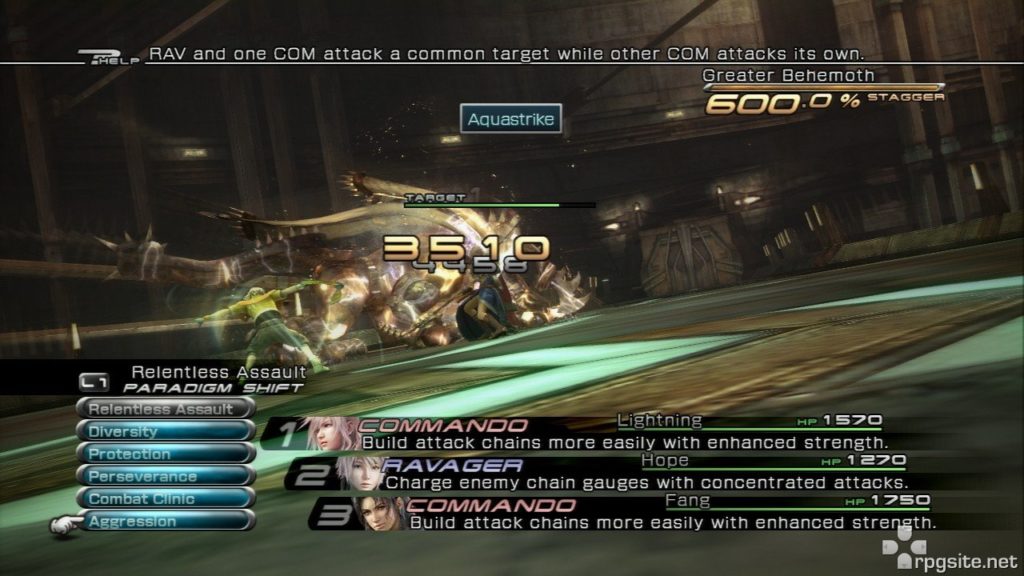Last updated on May 3, 2016
Part 3
So, you arrange each of your characters into these six role, up to six Paradigm setups in a Paradigm Deck. You can choose any assortment or allotment of classes, from three Ravagers to three Medics (though, quite honestly, a good mix of stuff is usually the most helpful). The fun part is that you can Paradigm Shift at any time, completely changing the roles and makeup of your party depending on the situation. Since the action can flow quite fast, it’s your job to manage the battle like a general; if you know a particularly devastating charge attack is coming up, then switch to a three Medic Paradigm. If you know the boss attacks lots of different characters, shift to a Paradigm with a Sentinel in it to reduce damage. If you need to keep the Chain Gauge up even during periods of heavy damage, consider keeping a Commando in the Paradigm slots to ensure a hard-built Chain Gauge from going to waste.
The AI, in this sense, is surprisingly adept. It’s mostly based on knowledge you obtain from an enemy. In whatever role they’re in, they’ll test for various weaknesses using various abilities until they find the most effective techniques to utilize. You can shortcut this process via Libra (the spell) and Librascope (the item), which will clarify all the monster’s various weaknesses. It’s so important to check this that the game even lets you see the monster’s weaknesses mid-battle, which tells you a lot about how the designers want you to approach battles. Know your stuff, and figure out how to survive long enough to kill whatever is in your path as efficiently as possible.
Your player character supplements this, so you can choose the playable character that 1. best fits the situation 2. lets you Launch enemies at the proper time 3. heals specific status ailments, and any other variety of things you want in your direct control (such as specific Eidolons and the like). Techniques supplement your main character’s arsenal, letting them summon Eidolons with devastating attacks or simply choosing to heal/debuff everyone (They cost Technique Points, which you earn by doing well in battles). That also follows for when party members learn abilities tailored for their best roles, like Lightning’s Ravager-specific Army of One attack (which fills the Chain Gauge up enormously, and the AI will never perform such specialized attacks). That strategy is all up to you, and you really have to “perform” your pre-planned strategy in the fly.
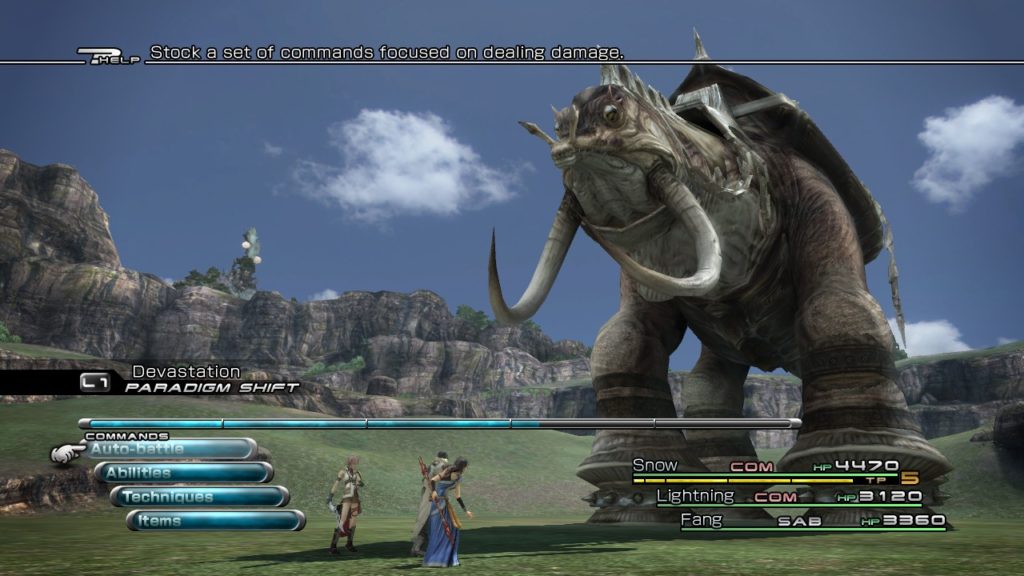
It sounds silly in text, but trust me: it’s pretty thrilling in practice. Managing the situation, especially when things look to be going south, is some of the most intense experiences you can have in a video game, especially in a 10+ minute boss fight where a mistake lands you back at square one. Not surprisingly, due to the considerable difficulty of battles, there’s an immediate “Retry” button which places you back in the party menu. This encourages a mentality of experimentation if you find yourself failing. Quite honestly, you never need to grind at all; the game gives you all the tools to figure out its myriad “battle puzzles”. Heck, they even give you a Rating upon finishing battles, which determines what kind of loot you get (low ranking get you helpful pre-battle items, high rankings get you miscellaneous items of various uses).
Winning a battle earns you Crystarium Points (CP), your new leveling currency; since Final Fantasy XIII follows in the footsteps of Final Fantasy X’s Sphere Grid and Final Fantasy XII’s License Board, this isn’t too much a surprise. The Crystarium, however, is relatively straightforward: use CP to move further into the tree of one of the six different roles. Since each character has various proficiencies in one role or another, getting useful abilities before other characters, it’s important to think about how you want to use CP. Sure, you can buy it all eventually if you grind, but making a smart move to get Haste for Sazh might just make the difference in an upcoming battle. Further, “grinding” only works to an extent since the game locks Crystarium development to a certain point until you best certain challenges. In my experience, it’s much more fun to figure out the fights on your own and figure out your own character development paths.
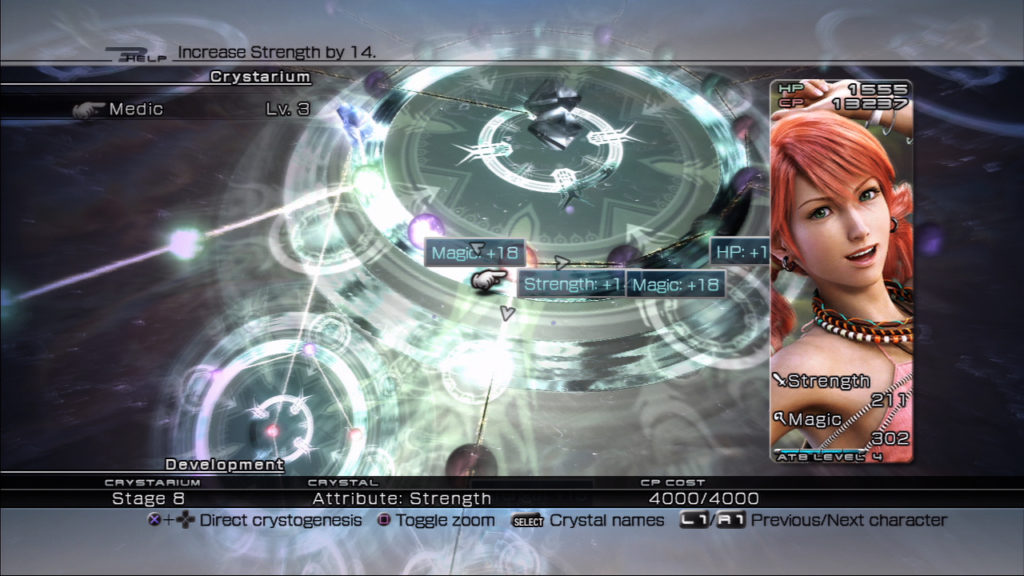
And that’s a very easy task, because the plot progression and battle progression work hand in hand. Think of the game as a series of hills and straight lines: each combat encounter is structured to teach you something new, by placing enemies in new formations and throwing you into situations with new party members. You choose whether to avoid encounters or get a pre-emptive strikes, but the game presents a very, very gradual learning curve. Many reviewers complained about this, but I enjoyed the chance to slowly learn all sorts of elements of the game experience as I go, until they literally and figuratively “open the game up” at about the 20 hour mark (this has a very distinct purpose in the aesthetics and plot as well!). All that groundwork means they can make the battles much, much more exciting and interesting as time goes on – I guess this is the best argument for not having random encounters that I’ve yet seen.
There is a weapon upgrading subsystem as well, assuming you need it. Weapons are your main choice of equipment, and they affect two stats: Strength and Magic (which, obviously, apply to Commando and every other magic-wielding role). Most weapons, however, hold special properties, like high stats at the expense of that character’s ability to stagger, or a massive increase in their physical and magic prowess at the expense of speed (or vice versa). These are all interesting choices, of course, but weapon upgrading is almost purely unnecessary and highly inefficient until the post-game content. It’ll help you best some fights, but never to the degree where they become trivial.
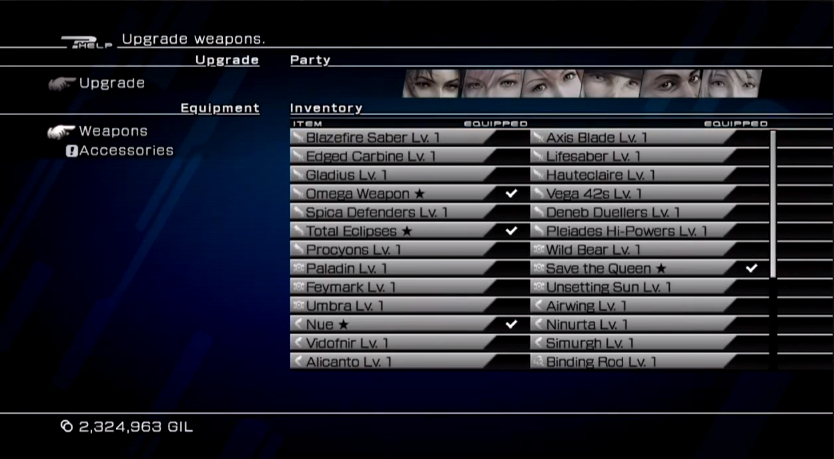
So, really, the only problem you could have with Final Fantasy XIII rests in the absolute purity of its systems. It has two things: plot, and combat, and really nothing else. It lacks a variety of elements to draw potential players into the fold, people who expect exploration, towns, and other such elements/tropes of a JRPG experience. The purity of its presentation and systems, along with a lack of interactivity, certainly didn’t endear it to many audiences. But, I can’t say that it doesn’t achieve what it set out to do, and in that respect Final Fantasy XIII is a success.
Still, there are genuine flaws beyond the possible complaints about the game’s structural elements. For example, summons (Eidolons) are pretty much useless towards the end of the game. While they present some pretty unorthodox boss fights in the main story, and revive/heal all your party members when they do their big ultimate attacks, they also completely drain the Chain Gauge of all enemies – not exactly helpful! They do prove useful at certain emergencies, but they present a far smaller bonus then you’d expect, given how much of the graphics budget they spent on them. Further, sometimes your party members group together when they should clearly be apart (when, say, a Sentinel needs to take tons of AoE spells). You can’t control where your party members are at any one time, just their actions, so this can make certain encounters rather frustrating for no particular reason. There’s also a clear optimal party for most of the game (Lightning, Fang, Hope), which you really should use unless you want to be frustrated.
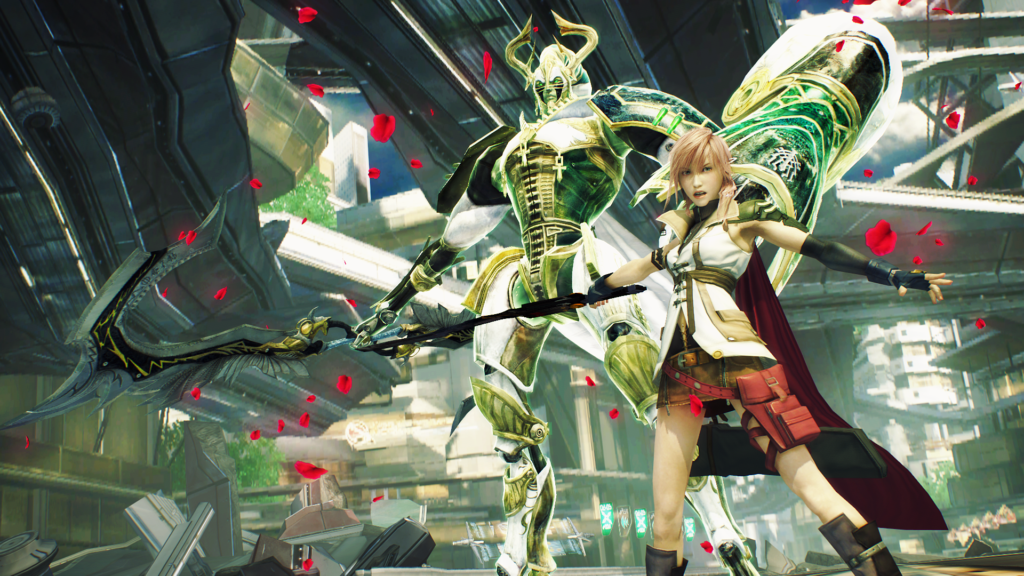
Lastly, to do some of the more interesting boss encounters in the post-game, you do need to grind money, transformation crystals (for ultimate weapons) and CP. That grinding isn’t particularly interesting, but it is mandatory, unfortunately. I suppose this won’t be a problem for most people, but it baffles me why they didn’t just have Gil drop off monsters or something, rather than forcing a grind of Perfumes or magic crystals from some pretty tough enemies. And that tells you a lot about the “Marks” side quest, similar to the Hunts in Final Fantasy XII – it’s just killing monsters. If you like the combat system, this is a great bonus, but if not you may as well put the game down once you’ve killed the final boss.
With all that said, you really should give Final Fantasy XIII a chance. Despite its reputation as a sort of “black sheep” and “the downfall of Square-Enix”, or whatever people have said, it’s definitely worth a try if only for how its integrated systems really work together. Someone put a lot of thought into linking the structure to the game, and while it’s not perfect by a long shot, it’s an entertaining, challenging experience from beginning to end.

